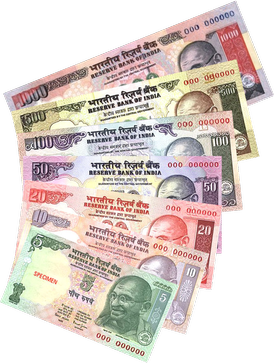
(Photo : Rupee--Wikipedia)
- The Indian rupee strengthened against the U.S. dollar due to likely inflows and a slump in the dollar index.
- The rupee's gain was facilitated by dollar sales from large U.S.-based banks.
- A drop in crude oil prices and a weaker dollar index contributed to the rupee's rise.
- The market is closely watching the U.S. Federal Reserve's upcoming announcements, which could influence the rupee's performance.
The Indian rupee, the official currency of India, experienced a significant boost on Tuesday, closing stronger against the U.S. dollar. This surge was primarily driven by likely inflows and a slump in the dollar index, which had a positive impact on Asian currencies across the board. The rupee closed at 83.7925 against the U.S. dollar, marking an increase of nearly 0.1% from its previous close of 83.87.
The rupee's performance on Tuesday was noteworthy, as it reached an intraday peak of 83.7650. This was its highest level since August 5, indicating a significant recovery from recent lows. The strengthening of the rupee was facilitated by dollar sales from at least two large U.S.-based banks, likely acting on behalf of custodial clients. This information was provided by a foreign exchange trader at a mid-sized foreign bank, who attributed the rupee's gain to both fundamentals and flows.
Impact of Dollar Index and Crude Oil Prices
The dollar index, which measures the U.S. dollar's value against a basket of foreign currencies, fell to its lowest level since January. This decline, coupled with a drop in crude oil prices, contributed to the rupee's rise. Brent crude oil futures were last quoted down 0.2% at $77.48 per barrel. This decrease in oil prices was due to easing supply concerns and China's economic weakness, which has been weighing on the demand outlook.
The rupee's performance was not an isolated event. Its regional peers, particularly the Indonesian rupiah, also experienced gains. The rupiah was up 0.7%, leading the pack. This trend of Asian currencies strengthening against the U.S. dollar was attributed to broad U.S. dollar weakness and risk-on sentiment, as noted by MUFG Bank.
Equity Market Performance and Federal Reserve's Role
The rupee's strong performance this week comes as a relief after it hovered close to record low levels for much of the previous week. This was due to outflows from local stocks and strong dollar demand from importers. However, the tide seems to be turning, with the benchmark Indian equity indexes, the BSE Sensex and Nifty 50, ending the day higher by about 0.5% each.
Looking ahead, the focus this week is on remarks from Federal Reserve policymakers, including Chair Jerome Powell, who is slated to speak on Friday. These remarks, along with the minutes of the Fed's July policy meeting due on Wednesday, will influence expectations of the extent and pace of rate cuts by the U.S. central bank. This is a key event that market participants are eagerly awaiting, as it could have significant implications for global financial markets, including the performance of the rupee.
In conclusion, the Indian rupee's performance on Tuesday was a result of a combination of factors, including likely inflows, a weaker dollar index, and falling crude oil prices. The currency's gain was also facilitated by dollar sales from large U.S.-based banks. Looking ahead, the focus is on the U.S. Federal Reserve's upcoming announcements, which could influence the rupee's performance in the coming days. The market will be closely watching these developments, as they could have far-reaching implications for the global financial landscape.
* This is a contributed article and this content does not necessarily represent the views of btin.co.in









